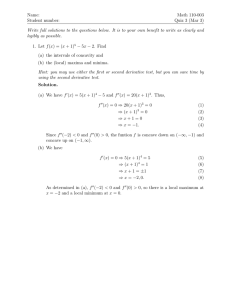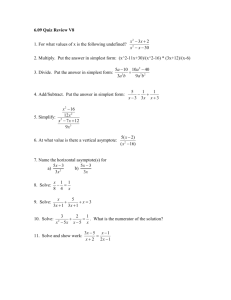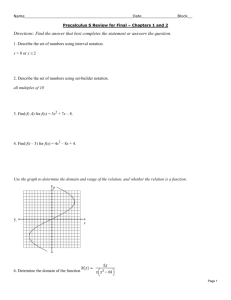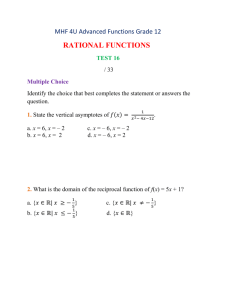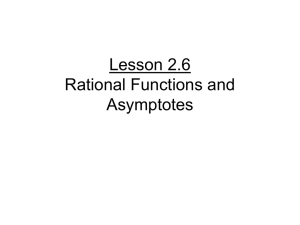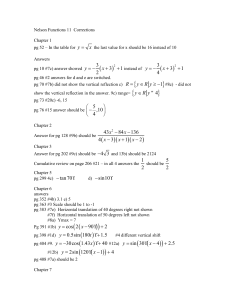MATH 1314 COLLEGE ALGEBRA Practice Midterm Exam 1
advertisement
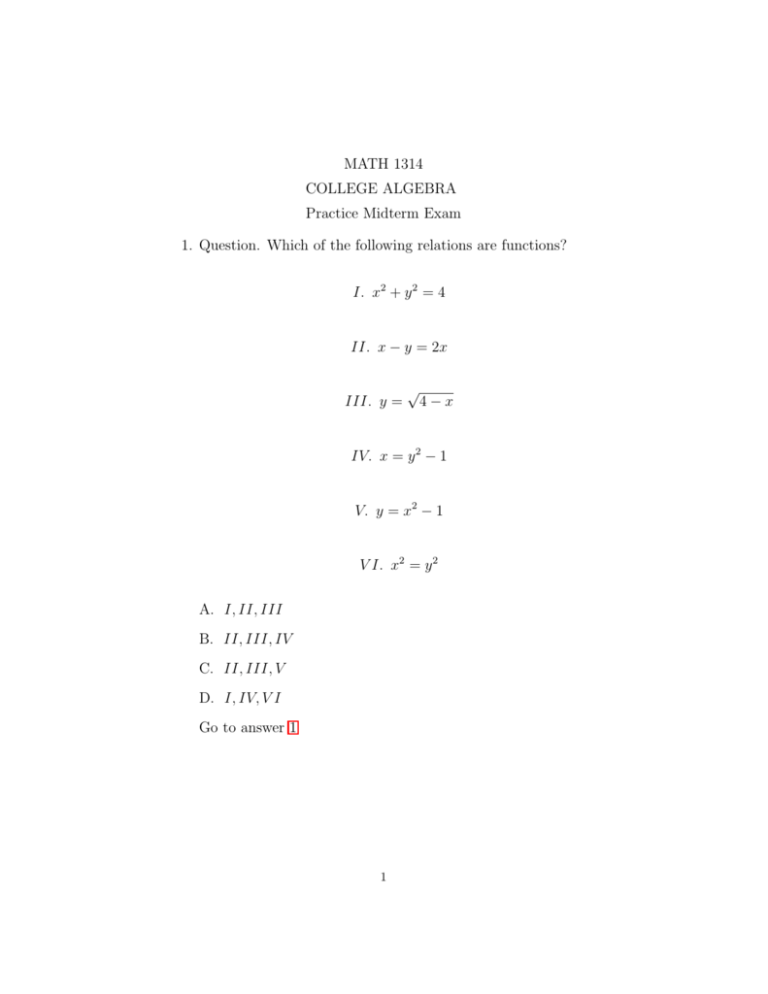
MATH 1314 COLLEGE ALGEBRA Practice Midterm Exam 1. Question. Which of the following relations are functions? I. x2 + y 2 = 4 II. x − y = 2x III. y = √ 4−x IV. x = y 2 − 1 V. y = x2 − 1 V I. x2 = y 2 A. I, II, III B. II, III, IV C. II, III, V D. I, IV, V I Go to answer 1 1 2. Question. Which of the following relation could have the set (−∞, 5] as its domain? A. x + y 2 = 5 √ B. y = x − 5 C. y = 1 x−5 D. y = |x − 5| Go to answer 2 3. Question. Given f (x) = x31 − 2x + 11, which of the following best describes the graph of the function y = x31 − 2x − 1? A. Vertical translation of the graph of y = f (x) by 12 units upward. B. Vertical translation of the graph of y = f (x) by 12 units downward. C. Horizontal translation of the graph of y = f (x) by 12 units to the left. D. Horizontal translation of the graph of y = f (x) by 12 units to the right. Go to answer 3 4. Question. Let y = f (x) be function satisfying f (2) = −5 and let y = f −1 (x) be the inverse of the function f . Find f −1 (−5). A. 1 −5 B. 5 C. 2 D. none of the above Go to answer 4 2 5. Question. Let f (x) = 7x + 13. The inverse function f −1 of the function f is: A. f −1 (x) = 1 7x+13 B. f −1 (x) = −7x − 13 C. f −1 (x) = x 7 − D. f −1 (x) = y 7 − 13 13 7 Go to answer 5 6. Question.Given f (x) = x31 − 2x + 11, which of the following best describes the graph of the function y = −x31 + 2x − 11? A. Reflection of the graph of y = f (x) in the x-axis. B. Reflection of the graph of y = f (x) in the y-axis. C. Reflection of the graph of y = f (x) in the origin (0, 0). D. Reflection of the graph of y = f (x) in the diagonal line y = x. Go to answer 6 7. Question. Which of the following is a factor of P (x) = 3x3 − 6x2 − 30x + 18? A. 3 B. x + 2 C. x − 2 D. x + 1 Go to answer 7 3 8. Question. Having found that (x − 2) is a factor of P (x) = 3x3 + 2x2 − x − 30, which of the following is another factor of P (x)? A. x + 3 B. x − 10.6 C. 3x2 + 8x + 15 D. none of the above Go to answer 8 9. Question. The standard form of the polynomial P (x) of degree 3 with real coefficients having zeros −2, 3, 1 and satisfying P (2) = −4 is A. P (x) = 3x3 − 6x2 − 15x + 18 B. P (x) = x3 + 2x2 − 5x + 6 C. P (x) = x3 − 2x2 − 5x + 6 D. P (x) = x3 − 2x2 − 5x − 6 Go to answer 9 10. Question. The number 2 is a zero of the polynomial P (x) =. Find all other zeros of P (x) = x3 − 4x2 + 9x − 10. A. 1, 3 B. 1 − i, 1 + i C. 1 + 2i, 1 − 2i D. 1 + 5i, 1 − i Go to answer 10 4 11. Question. The function f (x) = x (x−2)(x+3) has A. one oblique, one vertical asymptote and one horizontal asymptote B. two horizontal asymptote and one vertical asymptote C. one horizontal and two vertical asymptotes D. three vertical asymptotes Go to answer 11 12. Question. The function f (x) = x (x−2)(x+3) is A. positive in the intervals (0, 2) and (−∞, −3) B. positive in the intervals (2, ∞) and (−3, 0) C. positive in the interval (0, ∞) D. none of the above Go to answer 12 5 ANSWERS 1. Answer to Question 1 is ”C” Go back 1 2. Answer to Question 2 is ”A”. Go back 2 3. Answer to Question 3 is ”B”. Go back 3 4. Answer to Question 4 is ”C”. Go back 4 5. Answer to Question 5 is ”C”. Go back 5 6. Answer to Question 6 is ”A”. Go back 6 7. Answer to Question 7 is ”A”. Go back 7 8. Answer to Question 8 is ”C”. Go back 8 9. Answer to Question 9 is ”C”. Go back 9 10. Answer to Question 10 is ”C”. Go back 10 6 11. Answer to Question 11 is ”C”. Go back 11 12. Answer to Question 12 is ”B”. Go back 12 7

